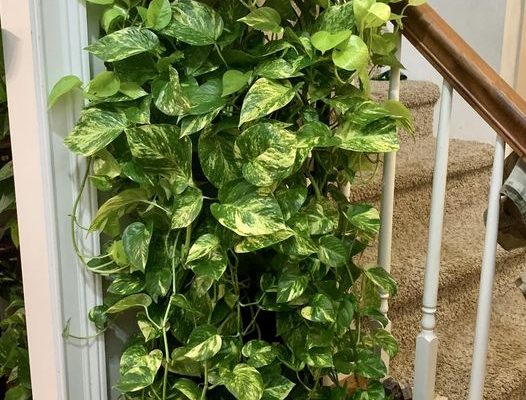Cultivars are both the treasure and bane of plant collectors.
Subtle variations between one Pothos variety and the next often mean you’re doomed to get a different plant than what you asked for.

It’s most commonly confused with ‘Marble Queen’ and ‘Emerald.’
Epipremnum Aureum ‘Global Green’ Care
Size And Growth
Depending on how well its preferred conditions are met, your global pothos may reach 5′ to 10 feet long.
It’s a relatively fast grower and loves having something it can climb, such as a bamboo pole or trellis.
It has rather large, glossy green leaves that can be up to 3’ feet long and are a mottled mix of emerald and lime-green variegation.
Each leaf is edged in a dark green border, resulting in a display that’s sure to please.
Flowering And Fragrance
Sadly, this cultivar won’t produce blooms. Instead, it has another minor claim to fame that sets it apart from many other pothos cultivars.
The tropical plant gives off a faint scent reminiscent of fresh herbs.
Bright Light And Temperature
No matter what variety of pothos cultivars you’re growing, it is tolerant to a wide range of light conditions. However, direct sunlight and cold drafts can scorch its attractive foliage.
Just as bad, poor light conditions, such as partial shade, can cause this plant’s variegation to fade.
Instead, you should aim for bright, indirect light, such as by a sunny window where the sun’s rays won’t directly hit the plant.
Remember, this plant should get at least 6 hours of bright, indirect sunlight daily.
Another popular option is to place it in an eastern or western window where it will catch the mild morning or evening sun but be protected from the harsh midday light.
A south-facing window will also ensure the plant will receive enough light to survive. It can also thrive under artificial light.
Global green pothos like moderate to moderately high humidity requirements of 50 to 70% percent.
This is a bit higher than you would normally find in a kitchen or bathroom (which can reach around 40% percent humidity levels), so some form of augmentation will be necessary.
Pebble trays are a popular option since you can fill a shallow tray with aquarium stones and a bit of water, then sit the plant pot on top of it.
You can also group your pothos with other humid-loving plants, and they’ll add moisture to the air around them like a full elevator in the dead of summer.
Finally, you can purchase a small humidifier to ensure the most accurate temperature range.
You won’t be able to grow ‘Global Green’ outdoors unless you live in USDA hardiness zones 10 to 12, and even then, they’ll need sheltering from sudden drafts or strong winds.
Indoors, however, this plant can live quite comfortably, preferring temperatures between 60° and 80° degrees Fahrenheit.
It’s an extremely cold-sensitive cultivar and can be seriously damaged or even die if temperatures drop below 50° degrees Fahrenheit.
If you live in a cooler climate but still wish to have your global green pothos outdoors, you can harden it off in late spring and keep it somewhere shielded from any harsh weather until late August, when you will want to bring it back inside
Watering And Feeding
Overwatering can be a serious threat to epiphytes (tree climbers) and hemiepiphytes (trailing plants that climb once they find a tree), as these plants actually draw much of their needed moisture and nutrients from the air.
As such, you will only need to water the plant when the top 1” to 2” inches of soil is dry between the watering schedule and should use either the soak-and-dry method or the bottom-up method.
Also, always check the soil moisture and lower the watering sessions if needed.
Another great feature of this pothos plant is that it needs very little in the way of fertilizer.
Many growers will use a balanced liquid-soluble houseplant fertilizer, like 7-7-7 or 14-14-14, once every 5 to 7 weeks during the spring and summer, especially for indoor plants.
A formulated houseplant liquid fertilizer will also work well during the growing season in spring and summer.
Others will use a naturally rich potting mix and add a bit of compost or fertilizer at the beginning of the growing season.
Soil And Transplanting
Global green pothos plants need loose, rich, well-draining soil to be their best. When container-grown, ensure that the post has a proper drainage system too.
Remember that standing in wet, soggy soil will cause problems.
As mentioned before, their aerial roots can draw many nutrients, but good organic soil will help keep the pH to a preferred 6.0 to 6.5.
There are a lot of great recipes out there for making a soil-free mix
The simplest involves 2 parts peat, 1 part perlite, and 1 part pine bark or orchid bark.
Ensure to add plenty of organic matter, such as coco coir, shredded leaves, or peat moss.
Other recipes can have six or seven ingredients but provide an extremely balanced growing medium.
If you go for regular potting soil, it’s hard to go wrong with an African violet mix that has a bit of extra perlite added.
You’ll need to repot this plant once every 2 to 3 years.
This performs a number of functions, such as replacing the old soil, which is likely spent and may also contain a buildup of harmful mineral salts.
It allows you to increase the container size if your pothos plants are becoming rootbound.
In addition, it creates a bushier plant.
You can (and should) also use this time to check for signs of root disease.
Grooming And Maintenance
As with any plant with large leaves, you will need to wipe off the foliage once or twice per week gently, and the lighter green textured leaves aren’t as efficient at photosynthesis even when they aren’t covered in dust.
You may also choose to give the plant a little annual pruning to encourage shape and remove any leggy stems.
If you see Pothos leaves that are badly infected or dying, removing them can help keep the rest of your plant healthy.
You can also support your plant with a moss pole to encourage compact growth and larger leaves.
In addition, ensure that your pothos plant is away from drafty windows, heating vents, or air conditioning units.
How To Propagate Global Green Pothos
Propagation of this hardy plant is almost always done via stem cuttings since it doesn’t bloom.
Air layering is also possible, although less efficient than using pothos cuttings.
You can start with a healthy, active vine from the mother plant.
However, before you attempt to propagate the hardy plant on your own, remember that the patent is active.
This means it’s technically illegal to propagate the vining plant without express permission from the patent holder.
Global Pothos Pests Or Diseases
Aphids, fungus gnats, mealybugs, and thrips are all potential problems for this plant, although not very common.
You’re also not likely to encounter any diseases unless the plant has suffered from poor care.
When this happens, fungal infections and root rot are the biggest concerns. If there’s a severe infestation, you will notice stunted growth, yellowing foliage, and mottled discoloration.
You can use neem oil or insecticidal soap to eliminate these insect pests.
Golden Pothos also hates the cold and excess moisture, so if you keep an eye on those two things, you’ll usually not run into any problems.
As with all pothos plants, this one contains high concentrations of calcium oxalate crystals.
Ingesting these crystals can be fatal for cats, seriously harmful to dogs, and not all that great for humans either.
While calcium oxalate exists in many popular foods (such as broccoli), the amount is very small, and large doses can lead to kidney stones and other nasty side effects.
What Is Global Green Pothos, And Where Did It Come From?
Nowhere is this more frustrating than with Epipremnum aureum (ep-ih-PREM-num AW-re-um), which still goes by the common name of golden pothos despite having been moved from that genus long ago.
Originating in French Polynesia, this proud member of the Araceae family has become a global phenomenon, with countless cultivars springing up every year.
It’s also been widely naturalized throughout subtropical and tropical climates in South Asia, Southeast Asia, South Africa, Australia, and the West Indies.
One such cultivar is the global green pothos (Epipremnum aureum ‘Global Green’) which has a bit of interesting history.
Often referred to as global pothos, this cultivar began its life as a natural mutation that Asaoka Hiroaki discovered in May 2016 while he was visiting a nursery in Aichi, Japan.
Mr. Asaoka successfully propagated the plant from cuttings that September, proving the mutation was stable.
He was granted a patent for the plant on October 4, 2019 (patent PP33530), and Costa farms were given permission to sell ‘Global Green’ the following year.
As of September 2021, Costa Farms announced they had been granted exclusive propagation right for this cultivar within the US.
Of course, this means global pothos can be quite hard to find, and other cultivars are often sold using its name.
Epipremnum Aureum ‘Global Green’ Uses
‘Global Green’ is a climber if you give it a chance. It’s an excellent addition to your indoor garden, providing a tropical vibe to your space.
Provide this tropical vine with a bamboo pole or other support, and let it climb up in the corner of your room. This will provide a stunning display of vines.
Alternatively, some people like to keep the plant in a hanging basket, where the massive Pothos leaves provide a wall of dappled glossy leaves.
However, remember that Global green pothos can be poisonous. Not all parts of this plant are toxic, but it may still cause severe medical conditions, such as difficulty breathing, blisters, excessive drooling, mouth irritation, and throat irritation if ingested.
So you must be mindful and careful when handling this plant.



